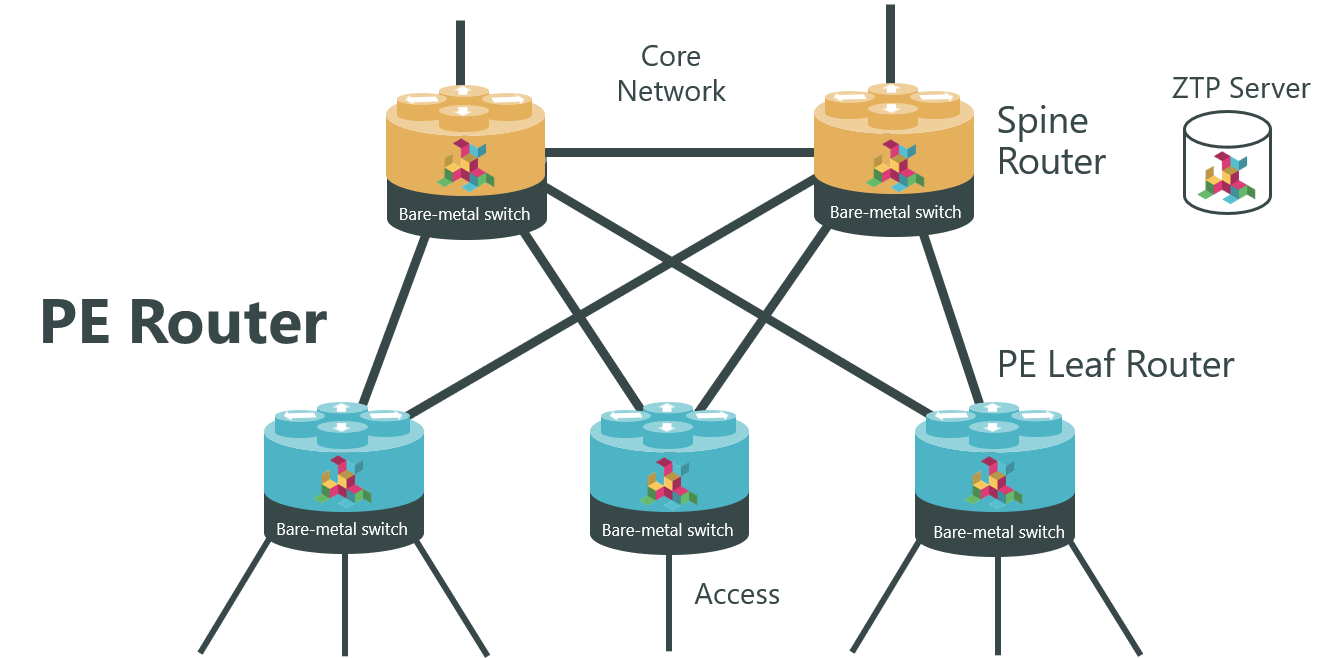L2 Metro Ethernet Switch Software
RtBrick Multiservice Edge routing software can also emulate L2 Metro Ethernet Services.
It is delivered as a software container, packaged out-of-the-box with the Open Network Linux (ONL) provided by the hardware SKU manufacturers, which handles peripherals such as LEDs, temperature sensors, and so on. There are no dependencies on either the kernel or the hardware platform components, so RtBrick’s containers can be run on the Linux version of your choice. The RtBrick PE Router software can run on either an x86 server, or for most carrier-scale deployments, on low-cost but powerful bare-metal switches.

Benefits
RtBrick’s disaggregated PE Router delivers some significant benefits compared to traditional monolithic systems:
- · Greater agility – you can add new services in weeks rather than years
- · Reduced risk – no more vendor lock-in and a simpler automated operating environment
- · Cloud cost-levels – leverage low-cost merchant silicon and automate your operations like a ‘cloud-native’
Agility
ZTP (Zero-Touch-Provisioning) ensures that each switch is booted, provisioned and operational without requiring manual intervention. This means that you can add capacity, or roll-out new service features, in a matter of minutes instead of days or weeks. The software itself is developed using Agile methodologies so that features are rapidly prototyped and implemented, reducing the time-to-market for new services.
Reduced risk
RtBrick’s PE Router software is compiled for your specific use-case, using only the features you need. With an order of magnitude fewer lines of code, and a single state database rather than hundreds, the whole system is less complex, less prone to bugs and has much faster restart times. It also allows you to pick and mix between the latest silicon and the best available software.
Cloud cost-levels
Now you can take advantage of the low cost-points of merchant silicon on your choice of bare-metal switches, significantly reducing your capex bill. And opex costs can be reduced by automating your operations, using ZTP and the same Web2.0 operational tools that the ‘cloud-natives’ use to run their infrastructure.
Deployment Options
The PE router's capacity can be scaled down to a single RU bare-metal switch or provided in a scale-out architecture called a Point-Of-Deployment (PoD).

Example of a Single RU bare metal switch
A large-scale PoD consists of a layer of PE Leaf Routers and a layer of Spine Routers in an auto-provisioned CLOS topology. The PE Leaves deliver service management functionality and the Border Leaves provide connectivity to the core of the provider network. The leaves can be scaled out horizontally to increase the number of customer connections supported on the PoD, providing a pay-as-you-grow architecture. For smaller PE routers, Spine and Leaf functionality can be collapsed onto a single hardware platform.

Large scale disaggregated L2 Ethernet Switch
L2 Cross Connect (L2X) allows your RtBrick PE Router to also act as a service cross-connect, routing each customer connections to the appropriate network infrastructure, and extending the life of your high-cost legacy routing systems, for example.
Management and Operations
Along with a traditional CLI, RtBrick’s Management API has been designed to simplify the integration with your existing OSS and BSS systems. It reduces the amount of time and effort required to make your disaggregated network operational, and it leverages widely-adopted industry tools and programming languages. RtBrick’s API is ‘consumer-driven’ – which means you can use the formats and languages of your choice, rather than have them imposed on you by a vendor. This allows you to build a client in Python, Go or Java, for example, as you prefer. And the APIs are all edited in Swagger, which is also a widely understood tool used by developers. RtBrick’s Management API actually comprises of several underlying APIs, which each follow the same consumer-driven approach.
Features
The features supported by RtBrick FullStack are expanding all the time, because it's much faster for us to add and test new features than it is using a traditional monolithic code base. You can see our current feature list on our latest data sheet.
Compatible Hardware
RtBrick's Full Stack routing software can operate on many bare metal switches, depending on your performance and port count requirements. You can find details of compatible hardware here.
